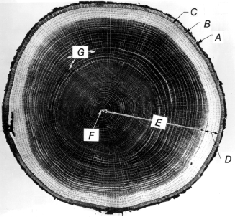E. Wood Cells
Wood cells—the structural elements of wood tissue—are of various sizes and shapes and are quite firmly cemented together. Dry wood cells may be empty or partly filled with deposits, such as gums and resins, or with tyloses. The majority of wood cells are considerably elongated and pointed at the ends; these cells are customarily called fibers or tracheids. The length of wood fibers is highly variable within a tree and among species. Hardwood fibers average about 1 mm (1/25 in.) in length; softwood fibers range from 3 to 8 mm (1/8 to 1/3 in.) in length.
In addition to fibers, hardwoods have cells of relatively large diameter known as vessels or pores. These cells form the main conduits in the movement of sap. Softwoods do not contain vessels for conducting sap longitudinally in the tree; this function is performed by the tracheids. Both hardwoods and softwoods have cells (usually grouped into structures or tissues) that are oriented horizontally in the direction from pith toward bark. These groups of cells conduct sap radially across the grain and are called rays or wood rays Fig. 2–1G). The rays are most easily seen on edge- grained or quartersawn surfaces, and they vary greatly in size in different species. In oaks and sycamores, the rays are conspicuous and add to the decorative features of the wood. Rays also represent planes of weakness along which seasoning checks readily develop. Another type of wood cells, known as longitudinal or axial parenchyma cells, function mainly in the storage of food.
Fig. 2-1
